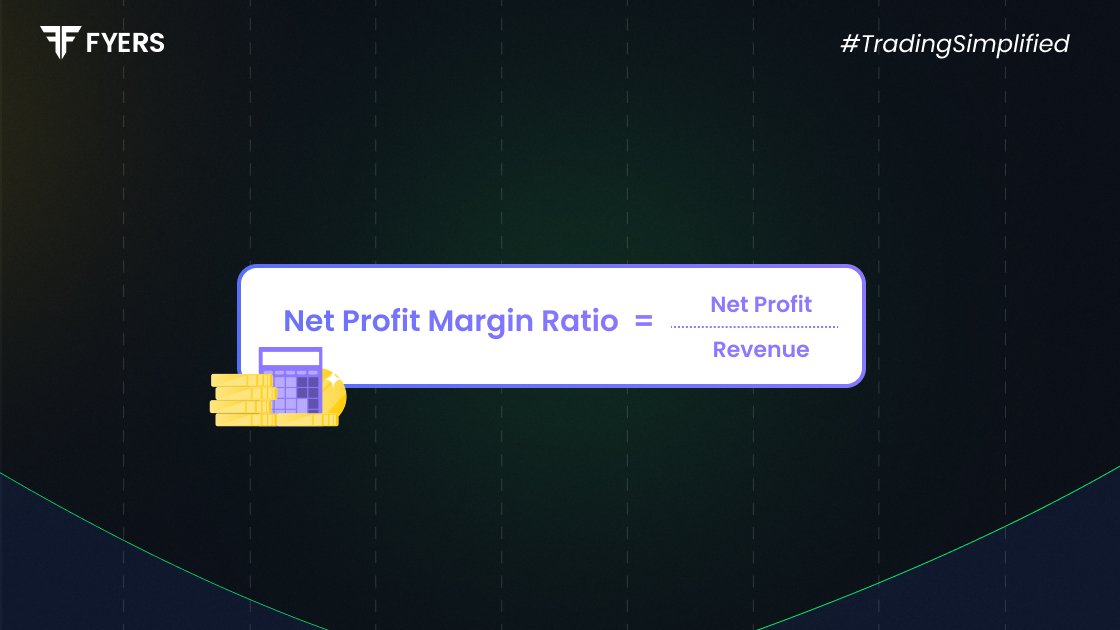

 31 Aug, 2025
31 Aug, 2025
 4 mins read
4 mins read

Understanding a company's profitability goes beyond just looking at how much money it makes. One of the most important indicators of financial health is the net profit margin. Whether you're an investor evaluating stocks or a business owner tracking performance, knowing how to interpret net profit margin can offer valuable insights into operational efficiency and overall viability.
Let’s explore what net profit margin really means, how it’s calculated, and why it matters.
Net profit margin is a financial ratio that shows the percentage of net profit a company earns from its total revenue. In simple terms, it tells you how much of every rupee earned by a company turns into actual profit after accounting for all expenses - including operating costs, interest, taxes, and depreciation.
If a company has a net profit margin of 20%, it means it earns ₹20 in profit for every ₹100 of revenue. A higher margin usually indicates better cost control and efficient operations.
The formula to calculate net profit margin is straightforward:
|
Net Profit Margin (%) = (Net Profit / Revenue) × 100 |
Where:
Net Profit is the income remaining after all expenses have been deducted from total revenue.
Revenue is the total income generated from business activities.
If a company earns ₹10 crore in revenue and ₹1.5 crore in net profit:
Net Profit Margin = (1.5 / 10) × 100 = 15%
This means the company retains ₹15 as profit from every ₹100 in sales.
Both gross profit margin and net profit margin help assess profitability, but they measure different stages of income:
|
Aspect |
Gross Profit Margin |
Net Profit Margin |
|---|---|---|
|
Formula |
(Gross Profit / Revenue) × 100 |
(Net Profit / Revenue) × 100 |
|
Includes |
Only direct costs (COGS) |
All expenses (COGS, OPEX, interest, tax, etc.) |
|
Focus |
Core production efficiency |
Overall financial performance |
Key Difference:
Gross margin focuses on how efficiently a company produces its goods, while net margin reflects the bottom line after all expenses.
Net profit margin is a critical metric for various reasons:
Performance Indicator: It reflects how well a company manages its expenses relative to income.
Investment Decisions: Investors use it to compare profitability across companies or sectors.
Benchmarking: Helps assess operational efficiency over time or against competitors.
Financial Planning: Guides decisions around pricing, cost control, and strategy.
Companies with consistently high net profit margins tend to be financially stable and resilient during economic downturns.
Several internal and external factors influence a company’s net profit margin:
Operating Costs: High fixed or variable costs can lower profitability.
Pricing Strategy: Competitive pricing may reduce margins, while premium pricing can increase them.
Taxation: Higher tax liabilities reduce net profits.
Interest Expenses: Loans or debt servicing can eat into profits.
Market Conditions: Economic downturns or inflation may impact revenues and costs.
Business Model: Asset-light models often have higher margins due to lower overheads.
Managing these factors effectively is key to maintaining a healthy margin.
While net profit margin is a powerful metric, it does have its limitations:
Non-operational items: One-time gains or losses can distort margins.
Industry Variance: Comparing across sectors may be misleading.
Accounting Policies: Depreciation methods or tax treatments can affect results.
Seasonality: Some businesses have fluctuating margins based on seasonal demand.
Hence, it’s best used along with other ratios like ROE, ROCE, and operating margin for a holistic view.
Net profit margin is a vital financial metric that gives insights into a company's efficiency in converting revenue into profit. While a high margin usually signals sound financial health, it’s essential to evaluate it in the context of industry norms, cost structures, and overall business strategy.
Whether you’re an investor, analyst, or entrepreneur, understanding this metric can sharpen your decision-making and help assess long-term sustainability.
Net profit margin is the percentage of revenue a company keeps as profit after paying all its expenses. It shows how much actual profit is earned from every rupee of sales.
A “good” margin depends on the industry. For example, IT companies may have margins above 15%, while retail businesses often operate with lower margins of 3%–5%. A higher margin generally indicates better financial health.
Gross profit margin measures profit after deducting production costs, while net profit margin accounts for all expenses, including admin, interest, and taxes. Net margin gives a more comprehensive view of overall profitability.
Yes, if a company’s total expenses exceed its revenue, the net profit will be negative, resulting in a negative margin. This indicates losses and could be a warning sign for investors or stakeholders.
Calculate your Net P&L after deducting all the charges like Tax, Brokerage, etc.
Find your required margin.
Calculate the average price you paid for a stock and determine your total cost.
Estimate your investment growth. Calculate potential returns on one-time investments.
Forecast your investment returns. Understand potential growth with regular contributions.